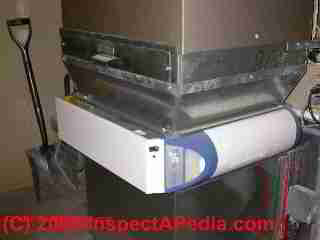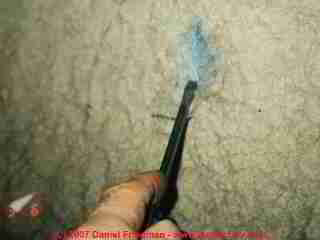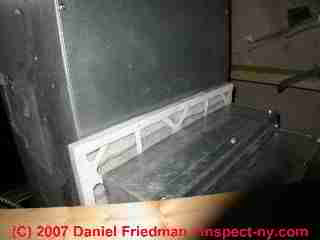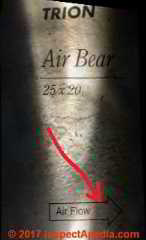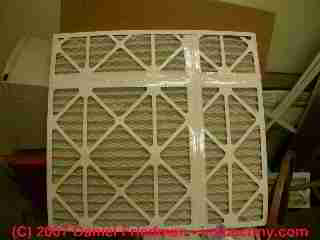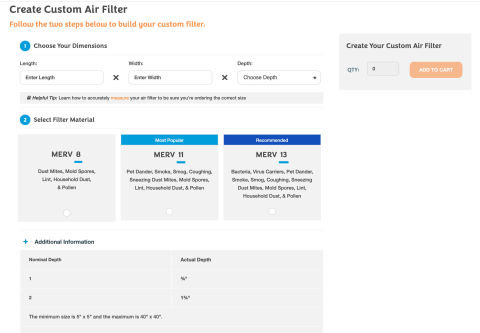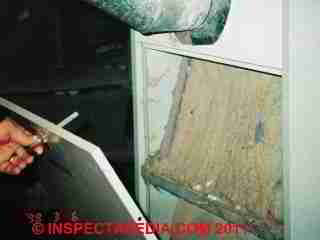 Air Filters, Heating & Air Conditioning Systems
Air Filters, Heating & Air Conditioning Systems
- POST a QUESTION or COMMENT about air filters: buying, installing, using, and problems with HVAC air filters
Air filters on HVAC systems:
Air filters for air conditioners, heat pumps, furnaces, including the air filter type, location, condition assessment, problems, and repairs.
This article series answers almost any question you might ask about air filters for central heating or air conditioning systems. We explain how an air conditioning service technician will diagnose certain common air conditioning system failures or defects.
In these articles we are referring to filters installed on central air conditioning or central heating systems that move air through air handlers and duct systems.
Standalone or portable "air cleaners" are generally ineffective in buildings where a problem particle reservoir is present, and they are not capable of removing an indoor air quality problem.
InspectAPedia tolerates no conflicts of interest. We have no relationship with advertisers, products, or services discussed at this website.
Air Conditioner, Heat Pump, or Furnace Air Filter Location, Condition, Problems, Repairs
First locate and document the placement of the HVAC system air filters - for examination and regular changing during the cooling season.
In our photo at left you can see a blue and white electrostatic air cleaner on the air handler.
But notice at the upper left of the photo just below the brown metal of the air handler body: see that silver sheet metal handle?
Removing the two screws on either end of the pull-out will permit you to expose another air filter that is in this location - the handle is a tip-off that the air handler is meant to be opened at this location in order to remove/replace an air filter.
Are these the only two air filters on this system? Nope.
Our discussion of cascaded air filters found at AIR FILTERS, OPTIMUM INDOOR includes photos of a front-end air filter found at the return air register.
In sum, finding a filter on a duct system or air handler is no promise that it's the only air filter installed. Inspect the system thoroughly. If more than one air filter is provided, document the location of all of the filters installed.
Next inspect the air conditioning filter type and condition. What about filters that are missing completely or are very dirty? What problems can a dirty or blocked air conditioner filter cause for the air conditioning system and how do we fix these snafus?
That's what we'll cover in this article.
Air conditioner filter location: filters should be readily accessible
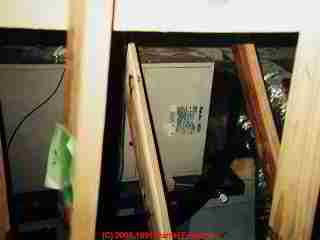
Filter accessibility: Air filters which are hard to access are rarely changed as often as necessary. We frequently see HVAC systems designed by someone who obviously has never had to service them.
Placement of filters and air handler access doors in very hard-to-access locations such as at the far end of a minuscule attic behind a forest of trusses means that the system is very unlikely to receive the periodic inspection and maintenance it needs.
We prefer to see A/C and heating filters placed at the building side of the air return register or grille, so as to protect the return duct from debris accumulation. The more common filter placement on many systems is right at or in the air handler.
After reading the text just below, if you still cannot find your heating or air conditioning system air filter read our detailed instructions on how to find air filters in our article:
Just below we summarize some common locations where air filters are found.
- At the central air return register, grille located in a wall or ceiling if your system uses centralized air returns instead of individual room-air return ducts. There may be several central return points, depending on the design of your system.
If there are more than two, chances are the filter was placed at the air handler instead of at these grilles. Unfortunately that means that the return ducts themselves become more soiled with dust and debris from the building. - At an attic air handler look for a slot which has a removable cover. The slot may be just an inch or so wide if 1" thick filters are used, or it could be several inches wide if a wide high-capacity pleated or similar filter was used.
The return air plenum on an attic or basement air conditioner blower unit will usually be a large metal enclosure about the same dimensions in width and height as the air conditioner blower unit itself. Look for a filter slot right where the return plenum contacts the blower fan assembly. - At a basement air handler we also look for a filter at the return air plenum which is often next to the bottom of the air handler if the system is an "up-flow" unit (or vice versa for the less common case of return air entering at the top of the air handler and exiting at its bottom).
- Next to an electrostatic air cleaner: if your air conditioning air handler has an electrostatic air cleaner installed, look for the filter, if there is one, next to the electrostatic air cleaner. In addition, the electrostatic air cleaner, which is a type of particle incinerating filter itself, needs to be removed and cleaned periodically.
(Check with your unit's manufacturer for cleaning interval and procedures. Often the electrostatic unit can be cleaned inside a dishwasher). Often there is also a thin metal washable air filter installed along with the electrostatic air cleaner.
Change your air filters every month when the air conditioning system is in operation. Make sure you find all of the filters as some systems have multiple filters and even multiple types of filters installed, such as a fiberglass or pleated paper filter, a washable filter, and an electrostatic air cleaner. These last two are cleaned, not replaced, when they're dirty.
Dirty Air Conditioner Filters Cause Multiple Problems for an Air Conditioning System
Dirty Air Filters: are a source of increased operating costs and poor cooling system operation. Dirty air filters can:- reduce air flow in the building
- cause dirt to accumulate on the fan blades, wasting your energy dollars
- cause excessive dirt build-up inside the duct system, leading to mold or allergen problems in a building and to the need for more costly duct cleaning or replacement
- block the cooling coil itself with dirt, reducing system effectiveness and possibly leading to costly repairs
- lead to frost build-up on the cooling coil and reduced or totally blocked air flow in the system
- eventually permit dirt to bypass the filter where it soils and blocks the blower fan itself, leading to more costly repairs.
The filters on an air conditioning or hot air heating system should be changed monthly when the system is in use. Discuss with your heating/cooling service professional the possible need to clean the blower fan and duct work.
See our detailed article about clogged air filters found
Improperly-Fit or Wrong Sized Air Filters Cause Bypass Leakage
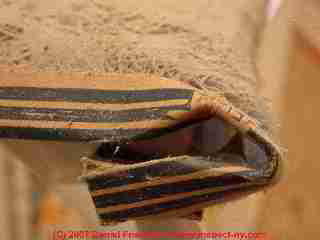
Bending over the end of an air conditioner or heating air handler filter such as shown in the photo at left above is a bad idea. If the filter does not fit there will be bypass leakage past the filter, soiling the blower fan, slowing air flow, and leading to more costly cleaning and service later.
Watch out: Furthermore when you bend the filter as this owner did, you interrupt the structural integrity of the filter's frame, risking filter collapse.
A collapsed air filter can be drawn right into the blower fan, causing damage to the fan motor or even leading to a fire! For an example
see HEAT RECOVERY VENTILATOR FIRE.
The photo at right shows how a college HVAC maintenance crew kept the A/C system running when the school did not have the proper filter size in stock. This filter installation also will have severe bypass leakage around the filter where the pleated section contacts the edges of the filter slot.
Installing a filter that is the wrong size for the heating or air conditioning air handler defeats the purpose of air filters because of leakage and it may be unsafe. Install a properly-sized filter in locations like this as soon as possible and watch out for unsafe filter collapsing.
At DIRTY COOLING COIL / EVAPORATOR COIL we give another example of what can happen if an air filter or air handler insulation fall against the cooling coil in an air conditioner or heat pump system.
How to Install or Replace an Air Filter in Heating or Air Conditioning Duct Systems
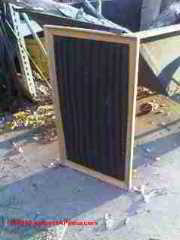
- Find all of the air filters or locations where air filters are supposed to be installed in your heating or cooling system.
Watch out: there may be multiple air filters to find, inspect, and replace.
See AIR FILTER LOCATION for help in finding where your air filters may be located. - Inspect the air filter that is already installed: is it dirty, bent, damaged, leaky? If so it should be replaced.
See DIRTY AIR FILTER PROBLEMS
and MISSING OR LEAKY AIR FILTERS - Write down the air filter measurements: thickness (usually not critical or usually standard anyway), and the dimensions (length and width). Providing that the filter already installed fit properly, you will want to buy an air filter that is the same size so that it will fit properly.
- Buy your replacement air filters. There are usually lots of choices in filter quality, fit, gaskets, etc. An air filter that has gaskets will be less leaky and the HVAC system will operate more efficiently with one installed.
An air filter that has increased filtering capacity may help reduce the level of airborne dust, pollen, mold in your building.
Watch out: if you install an air filter that is so dense that it significantly reduces air flow through the system, the delivery of conditioned air (heated or cooled) may be noticeably reduced. - Install your new air filter, making sure it is seated properly, not bent or damaged, and that it is facing the right way: arrows on the filter edges show the direction of air flow through the filter.
Watch out: installing an air filter facing the wrong way can cause a fire if the filter material is drawn into the blower fan assembly, or it can cause a blocked cooling coil and cooling coil icing if the filter is in the supply plenum ahead of the cooling coil.
See "Loose Supply Plenum Insulation Falls onto A-Coil" discussed
at DIRTY COOLING COIL / EVAPORATOR COIL where we discuss dirty, clogged, or totally-blocked cooling coils.
Question: How do I know which way my air filter should face when it is installed?
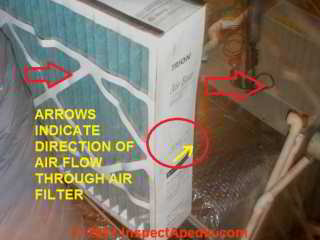 I am in the process of changing the filters in my new home for the first time - there are three located in various areas, easily accessible
I am in the process of changing the filters in my new home for the first time - there are three located in various areas, easily accessible
. I have purchased the correct sizes. Although marked by "air flow" arrows, I'm still confused as to which way they should be installed - does the "webbed grill" side face in or out?
I know this may be a "no brainer" but it is a first for me and I want to make sure I place them correctly. - Beverly Upperman
[Click to enlarge any image]
Reply:
Think about the problem we need to avoid: if an air filter gets sucked into a duct or worse, into a blower fan assembly, it can jam the blower fan, cause a motor overheat, and even cause a fire.
So we want the air filter to be placed so that its reinforced side will prevent it from being drawn into the duct or blower system.
Air filters have an arrow on their edges to give us a clue about how they should be placed. Insert the air filter so that the arrow is facing in the same direction as the direction of air flow through the filter.
Our photo above shows a Trian pleated air filter. On the side of the filter you will see the arrow showing that the filter should be placed so that air will move through the filter in the same direction as pointed-to by the arrow. Below is a closeup of that airflow direction arrow:
So if you are placing a filter on an HVAC system central air return grille, air is "returning" or "entering" the grille from the building, so air is flowing from the building into the duct system at that location. So the arrow would point the same way - into the duct system.
Attic Air Handler Air Filter Location & Position
Our photo above shows the attic location of the air handler for an air conditioning system. The red arrows indicate the direction of air flow: [Click to enlarge any image]
- Return air coming from the building occupied space passes through the return duct
- into the air handler
- through the pleated air filter [click to enlarge and you'll see the direction arrow on the air filter top side]
- into the return air plenum and onwards across the cooling coil
The blower fan itself and the supply plenum and remaining ductwork are not visible in this cramped-condition attic air handler photo.
Watch out: There is an air conditioning system maintenance lesson here: when the installer locates an air handler where it is difficult to access, requiring squirming through roof truss webs and over loose piles of insulation in an attic, for example, nobody wants to go there to service the unit. An air filter in this location is a horrible design as it's likely to go for years without change.
Watch out: installing an air filter facing the wrong way can cause a fire if the filter material is drawn into the blower fan assembly, or it can cause a blocked cooling coil and cooling coil icing if the filter is in the supply plenum ahead of the cooling coil.
See "Loose Supply Plenum Insulation Falls onto A-Coil" discussed
at DIRTY COOLING COIL / EVAPORATOR COIL where we discuss dirty, clogged, or totally-blocked cooling coils.
Construct or Obtain Large or Special-dimension HVAC System Air Filters
The same college HVAC maintenance staff who was struggling with improperly-fit air filters we discussed earlier was also faced with the task of coming up with a much larger air filter for the air conditioner air handler over their computer center.
Watch out: beware of cutting and modifying a store-bought air filter to fit your system.
The neatly-taped "built-up" air filter shown in this photo was nicely constructed but we don't recommend this practice:
- The filter may come apart and send fragments into the blower assembly, damaging the blower or leading to overheating and a fire.
- The filter is not delivering the total cross-section of filtering area that was anticipated by the HVAC design engineer who specified the dimensions of the return air plenum at which this filter was installed - we're seeing less total CFM of airflow.
Incidentally, except unusual cases with special requirements, wouldn't it have made sense for the HVAC or duct system designer to have specified a filter that is one of the many standard sizes?
Where to buy custom-sized HVAC air filters
Air filter suppliers and manufacturers have no trouble providing air filters of special dimensions. Furthermore if the filter is built by a manufacturer it's more likely that they'll understand the structural and strength requirements of the filter as well as the required airflow characteristics and filtering ability.
Illustration, from Air Filters Delivered, cited below.
Options include at least these
- Check with your local HVAC suppliers as they may in fact already have the air filter you need
- Contact the manufacturer of your HVAC equipment directly
- A quick web search for "buy custom HVAC air filters" finds dozens of suppliers who will build and ship air filters of a specific dimension in length, width, and thickness as well as filter type or rating.
Examples (July 2022) inlcude:
Air Filters Delivered - https://www.airfiltersdelivered.com/custom-filters - easy web page fill-in air filter dimensions & place order - illustrated above
Air Filters Incorporated - https://www.airfilterusa.com/order-custom-air-filter Tel: 1 (800) 250.4071
Filterbuy Custom Air Filters - https://filterbuy.com/custom-air-filters/ Tel: (855) 345-8289
The Effects of & Problems Caused by Missing Air Conditioner Filters
See our detailed article at MISSING or LEAKY AIR FILTERS Excerpts are below.
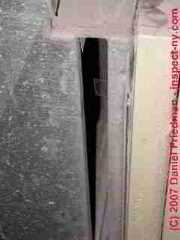
Look closely at this photograph. On the right we can see a tan "Air Filter Cover" plate which marks the intended location of the HVAC air filter. But there is an open slot to the left of the air filter cover, possibly where another filter was previously being installed.
When the new air filter slot was constructed and nicely covered (so as not to leak) the old slot was simply left open.
You can see my piece of adhesive tape bending into the opening, demonstrating (not too scientifically) that there was airflow into the unit from this location.
This is a great way to draw attic insulation fiberglass into the air handler and to blow it into the living area. And of course any other unwanted attic dust and debris is also being invited into the air handling system and blown into the occupied space.
Failure to properly filter dust from the return air supply will load the fan and cooling coil, dirty the duct system, and lead to the problems listed above.
Mold on HVAC System Air Filters
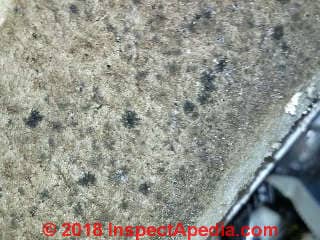
Watch out: As the ductwork debris level increases you increase the risk of forming an allergen or mold reservoir, especially if there are water or condensate leaks into the duct system interior.
The photograph above, provided by an anonymous reader, is reported to show mold growth on an HVAC system air filter. More about mold in HVAC system ducts and on air filters is
at AIRBORNE PARTICLE & MOLD LEVELS in DUCTWORK.
If Your Air Conditioner or Warm Air Heater Doesn't Have Air Filters, Install One or More Filter
If an air filter is not present on your air conditioner or warm air heating furnace system, have one installed. Installing an air filter is normally a minor expense involving placement of a rack to hold the air filter at each return air register, and installation of the air filter itself.
The alternative to installing and maintaining good air filtration on any air conditioner or warm air heating system is dirty ductwork and a dirty air handler. Duct cleaning or duct replacement can be a significant expense. Cleaning up a moldy HVAC system, where mold may have been caused by coil icing which was caused by a dirty coil or filter is still more costly.
Reader Comments, Questions & Answers About The Article Above
Below you will find questions and answers previously posted on this page at its page bottom reader comment box.
Reader Q&A - also see RECOMMENDED ARTICLES & FAQs
Question: I cant' find the right air filters for my system
I have 2 wall convector units in my apt.
Having a difficult time finding replacement filters.
21 ½” long
7 ½” wide
31 1/2 “ long
7 ¾” wide
- Anonymous by private email 2022/07/17
Moderator reply:
An exact fit filter you can almost certainly buy filters that can be cut to size.
This may seem a little obscure encouragement but one thing I tell myself when a problem like this comes up is that it's almost certain that other people have encountered the same problem and there's a solution.
You ought to be able to just do a search on filter size to find a replacement.
Else I would contact the manufacturer.
In case it wasn't obvious I'll explain that we can't provide the filters that you need. Inspectapedia doesn't sell anything, no products, no service. That's an order to protect reader trust that there's no conflict of interest.
On 2021-07-29 by inspectapedia.com.moderator (mod) - adding air filters to the HVAC ductwork?
@Dan,
The rub is that if you add very high filtration at your supply registers you'll so constrict the air flow as to prevent proper operation of your heating or cooling system.
1. Have the ducts inspected for damage; if the fiberglass mat liner material is un-damaged and not moldy it's not likely to be shedding significant levels of fiberglass (nor mold) into room air.
2. Collect and have tested representative samples of settled dust to see if there are significant levels of problem particles - those can point to a problem source;
3. PLEASE READ FIBERGLASS HVAC DUCTS
you're welcome to post further questions or comments, but posting there hits a better segment of readers and experts
On 2021-07-29 by Dan - Is there a sub micron cloth I could use to capture small particulates at the register?
I have a house built in the 70’s with rectangular metal duct work
Inside these ducts are fiber panels with exposed fibers around the perimeter.
We are experiencing sore throats after sleeping in the home for a couple nights.
Is there a sub micron cloth I could use to capture small particulates at the register? Is there a good recommendation on that filter fabric?
This Q&A were posted originally at InspectApedia.com HOME
...
Continue reading at AIR FILTER CLEANER EFFECTIVENESS or select a topic from the closely-related articles below, or see the complete ARTICLE INDEX.
Or see AIR FILTER FAQs - questions & answers posted originally at this page
Or see these
Recommended Articles
- AIR FILTER LOCATION.
- AIR FILTER CLEANER EFFECTIVENESS
- AIR FILTERS, OPTIMUM INDOOR
- AIR FLOW TOO WEAK.
- AIRBORNE PARTICLE & MOLD LEVELS in DUCTWORK
- DIRTY AIR FILTER PROBLEMS
- MISSING or LEAKY AIR FILTERS
- SOURCES FOR AIR FILTERS - suppliers
Suggested citation for this web page
AIR FILTERS for HVAC SYSTEMS at InspectApedia.com - online encyclopedia of building & environmental inspection, testing, diagnosis, repair, & problem prevention advice.
Or see this
INDEX to RELATED ARTICLES: ARTICLE INDEX to BUILDING INDOOR AIR QUALITY IAQ
Or use the SEARCH BOX found below to Ask a Question or Search InspectApedia
Or see
INDEX to RELATED ARTICLES: ARTICLE INDEX to AIR CLEANERS FILTERS PURIFIERS
Or use the SEARCH BOX found below to Ask a Question or Search InspectApedia
Ask a Question or Search InspectApedia
Questions about air filters: buying, installing, using, and problems with HVAC air filters .
Try the search box just below, or if you prefer, post a question or comment in the Comments box below and we will respond promptly.
Search the InspectApedia website
Note: appearance of your Comment below may be delayed: if your comment contains an image, photograph, web link, or text that looks to the software as if it might be a web link, your posting will appear after it has been approved by a moderator. Apologies for the delay.
Only one image can be added per comment but you can post as many comments, and therefore images, as you like.
You will not receive a notification when a response to your question has been posted.
Please bookmark this page to make it easy for you to check back for our response.
Our Comment Box is provided by Countable Web Productions countable.ca
Citations & References
In addition to any citations in the article above, a full list is available on request.
- Modern Refrigeration and Air Conditioning, A. D. Althouse, C.H. Turnquist, A. Bracciano, Goodheart-Willcox Co., 1982
- Principles of Refrigeration, R. Warren Marsh, C. Thomas Olivo, Delmar Publishers, 1979
- Wikipedia Web: https://www.wikipedia.org/ provided background information about the definition of HEPA and airborne particle interception
- Thanks to reader Beverly Upperman for discussing air filter installation details - August 2010
- Our recommended books about building & mechanical systems design, inspection, problem diagnosis, and repair, and about indoor environment and IAQ testing, diagnosis, and cleanup are at the InspectAPedia Bookstore. Also see our Book Reviews - InspectAPedia.
- Complete List of Air Conditioning & Heat Pump Design, Inspection, Repair Books at the InspectAPedia Bookstore.
- In addition to citations & references found in this article, see the research citations given at the end of the related articles found at our suggested
CONTINUE READING or RECOMMENDED ARTICLES.
- Carson, Dunlop & Associates Ltd., 120 Carlton Street Suite 407, Toronto ON M5A 4K2. Tel: (416) 964-9415 1-800-268-7070 Email: info@carsondunlop.com. Alan Carson is a past president of ASHI, the American Society of Home Inspectors.
Thanks to Alan Carson and Bob Dunlop, for permission for InspectAPedia to use text excerpts from The HOME REFERENCE BOOK - the Encyclopedia of Homes and to use illustrations from The ILLUSTRATED HOME .
Carson Dunlop Associates provides extensive home inspection education and report writing material. In gratitude we provide links to tsome Carson Dunlop Associates products and services.


